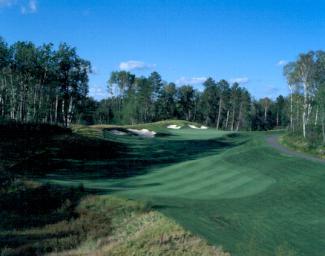Featured Golf News
Yet More on Green-Backing Mounds
When designing greens, and their backdrops, there are several reasons to use a series of low ridges or mounds behind the green, other than holding errant shots near the green, as previously described:

1. Focus the golfer's eye on the green - the ultimate target.
2. Provide definition for the back edge of the green.
3. Provide a setting, visual scale and depth perception.
4. Furnish a safety buffer to adjacent play area.
5. Back mounds are used do divert drainage around the putting surface.
6. They provide up slopes for us to build visible bunkers.
In fact, on gently rolling land, the most natural green sites are at the midpoint of a gentle upslope, which provides natural backdrop above the green. Hole No. 15, at the Quarry, Biwabik, Minn., shown below, typifies a green site most architects look for.
The landform behind the green with two bunkers is natural, and all we needed to do is cut in those two back bunkers. Even on the best green sites, some artificial enhancement is needed to create the proper setting. We did need to build the ridge supporting the two bunkers front-left, and while they are actually separated by several yards, are designed to visually flow from one to the other.
Meanwhile, at the front of the green, the fairway gently sweeps up to the green providing an opportunity for a run in shot, if required, and nice visual appeal. A lower green and flatter approach wouldn't have been as attractive.
A green's final elevation is also a factor of trying to balance the cut and fill required for the final shape, as it is expensive to haul fill in or out to build the green.
The key to good-looking manmade (by bulldozer) mounds, ridges and earth forms are:
• Mimic natural contours in slope, angle, and variety. Natural slopes are seldom as constant as bulldozer built slopes, so this is a constant battle. We sometimes tell operators to go back and "nick" or "distress" the surface, to create more variety.
• As a rule of thumb, maximum grade should be about double the natural grade (i.e., 10% when natural grade is 5%). Sometimes it takes more (i.e., 30% when natural grade is 10%) to fit a green on a sloping site.
• The sky line (or top edges) is most visible, and should rarely exceed a 10-15% slope from the golfer's view angle.
• The base of any ridge should fan out gently to meet the natural grade to make it blend into the natural topography. If side-slopes are 4-5 to 1, at the bottom they should fan out to 6-, then 7- then 8-to-1 slopes before they catch up to existing ground.
• The same is true of the top of mounds, as rounded "domes" mounds appear artificial. Side-slopes should taper off slightly near the mound top.
Studying early architects, it's obvious that the earthworks around the green were painstakingly fashioned. They had the "advantage" of slower construction processes, allowing more time for subtle changes. Also, the horses used to haul scoops of dirt didn't try to organize things as much as humans might.
For the first installment of green-backing mounds, visit http://www.cybergolf.com/golf_news/greenbacking_mounds.
Jeffrey D. Brauer began his career as an apprentice in the Chicago area in 1977. His first project was Kemper Lakes, which shortly after hosted the 1989 PGA Championship. He formed GolfScapes in Arlington, Texas, in 1984. In the last 29 years he has designed and consulted on a wide spectrum of projects, ranging from partial renovations to international resorts. His recent work includes teaming with the design team of Pascuzzo and Pate on a remodel of the world-famous La Costa Resort & Spa in California, and renovations at Superior National Golf Course in Lutsen, Minn., and Mesquite Municipal Golf Course in Mesquite, Texas.
He has been a member of the American Society of Golf Course Architects since 1981, serving as President during its 50th Anniversary year in 1995-96. Jeff still studies the classic works - both old and new, and has played more than 75 of the best courses in the world.
Jeff gives many presentations and is a regular architecture columnist for many publications and websites, including Golf Course Industry and Cybergolf.com. He has also been a strong advocate for the "Tee it Forward" campaign and strives to make his courses fit the description of "fun to play every day."
Jeff's work has been spotlighted in most of the world's major golf magazines. Golf World ranked him as one of the top-20 golf course architects and Golf Inc. ranked him as the world's fourth-best value in golf architecture in 2010. Jeff's portfolio and reputation keep him at the forefront of desired designers for new courses, reconstruction and renovation projects. For more about Jeff, visit http://www.jeffreydbrauer.com/sites/courses/layout.asp?id=859&page=48451.
Story Options
 |
Print this Story |
